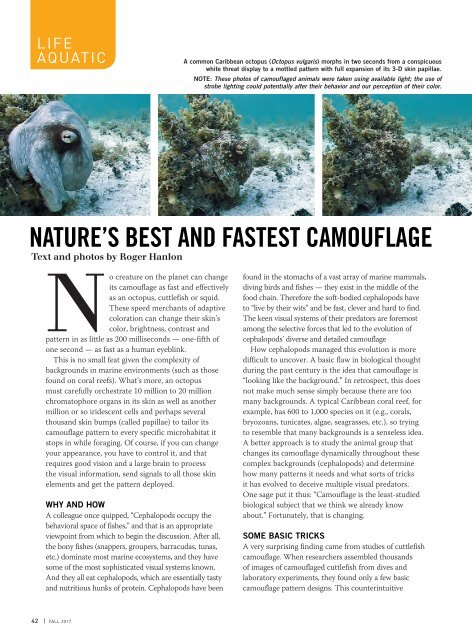AD 2017 Q4
Alert Diver is the dive industry’s leading publication. Featuring DAN’s core content of dive safety, research, education and medical information, each issue is a must-read reference, archived and shared by passionate scuba enthusiasts. In addition, Alert Diver showcases fascinating dive destinations and marine environmental topics through images from the world’s greatest underwater photographers and stories from the most experienced and eloquent dive journalists in the business.
Alert Diver is the dive industry’s leading publication. Featuring DAN’s core content of dive safety, research, education and medical information, each issue is a must-read reference, archived and shared by passionate scuba enthusiasts. In addition, Alert Diver showcases fascinating dive destinations and marine environmental topics through images from the world’s greatest underwater photographers and stories from the most experienced and eloquent dive journalists in the business.
Create successful ePaper yourself
Turn your PDF publications into a flip-book with our unique Google optimized e-Paper software.
LIFE<br />
AQUATIC<br />
A common Caribbean octopus (Octopus vulgaris) morphs in two seconds from a conspicuous<br />
white threat display to a mottled pattern with full expansion of its 3-D skin papillae.<br />
NOTE: These photos of camouflaged animals were taken using available light; the use of<br />
strobe lighting could potentially alter their behavior and our perception of their color.<br />
NATURE’S BEST AND FASTEST CAMOUFLAGE<br />
Text and photos by Roger Hanlon<br />
No creature on the planet can change<br />
its camouflage as fast and effectively<br />
as an octopus, cuttlefish or squid.<br />
These speed merchants of adaptive<br />
coloration can change their skin’s<br />
color, brightness, contrast and<br />
pattern in as little as 200 milliseconds — one-fifth of<br />
one second — as fast as a human eyeblink.<br />
This is no small feat given the complexity of<br />
backgrounds in marine environments (such as those<br />
found on coral reefs). What’s more, an octopus<br />
must carefully orchestrate 10 million to 20 million<br />
chromatophore organs in its skin as well as another<br />
million or so iridescent cells and perhaps several<br />
thousand skin bumps (called papillae) to tailor its<br />
camouflage pattern to every specific microhabitat it<br />
stops in while foraging. Of course, if you can change<br />
your appearance, you have to control it, and that<br />
requires good vision and a large brain to process<br />
the visual information, send signals to all those skin<br />
elements and get the pattern deployed.<br />
WHY AND HOW<br />
A colleague once quipped, “Cephalopods occupy the<br />
behavioral space of fishes,” and that is an appropriate<br />
viewpoint from which to begin the discussion. After all,<br />
the bony fishes (snappers, groupers, barracudas, tunas,<br />
etc.) dominate most marine ecosystems, and they have<br />
some of the most sophisticated visual systems known.<br />
And they all eat cephalopods, which are essentially tasty<br />
and nutritious hunks of protein. Cephalopods have been<br />
found in the stomachs of a vast array of marine mammals,<br />
diving birds and fishes — they exist in the middle of the<br />
food chain. Therefore the soft-bodied cephalopods have<br />
to “live by their wits” and be fast, clever and hard to find.<br />
The keen visual systems of their predators are foremost<br />
among the selective forces that led to the evolution of<br />
cephalopods’ diverse and detailed camouflage<br />
How cephalopods managed this evolution is more<br />
difficult to uncover. A basic flaw in biological thought<br />
during the past century is the idea that camouflage is<br />
“looking like the background.” In retrospect, this does<br />
not make much sense simply because there are too<br />
many backgrounds. A typical Caribbean coral reef, for<br />
example, has 600 to 1,000 species on it (e.g., corals,<br />
bryozoans, tunicates, algae, seagrasses, etc.), so trying<br />
to resemble that many backgrounds is a senseless idea.<br />
A better approach is to study the animal group that<br />
changes its camouflage dynamically throughout these<br />
complex backgrounds (cephalopods) and determine<br />
how many patterns it needs and what sorts of tricks<br />
it has evolved to deceive multiple visual predators.<br />
One sage put it thus: “Camouflage is the least-studied<br />
biological subject that we think we already know<br />
about.” Fortunately, that is changing.<br />
SOME BASIC TRICKS<br />
A very surprising finding came from studies of cuttlefish<br />
camouflage. When researchers assembled thousands<br />
of images of camouflaged cuttlefish from dives and<br />
laboratory experiments, they found only a few basic<br />
camouflage pattern designs. This counterintuitive<br />
42 | FALL <strong>2017</strong>









